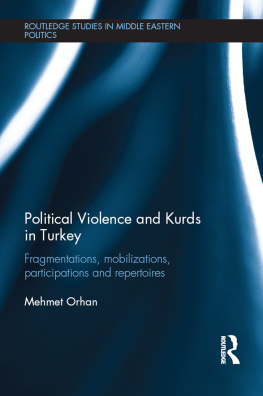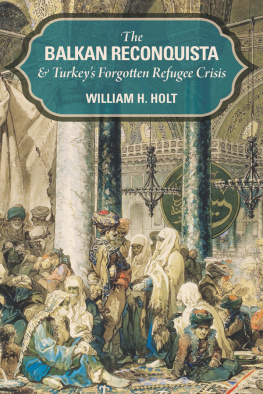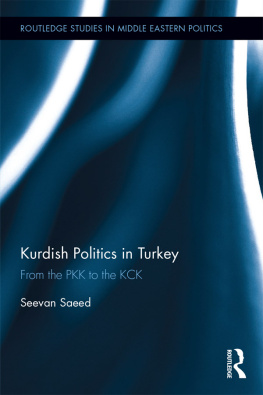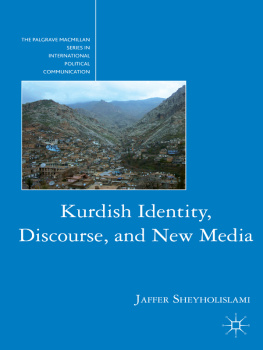Anna Grabolle-eliker, a German-British anthropologist, received her PhD from Tbingen University. She has lived in Turkey since 1997, working first as a language teacher and translator, and then as a university lecturer.
KURDISH LIFE IN CONTEMPORARY TURKEY
Migration, Gender and Ethnic Identity
ANNA GRABOLLE-eliker
New paperback edition published in 2015 by
I.B.Tauris & Co Ltd
London New York
www.ibtauris.com
First published in hardback in 2013 by I.B.Tauris & Co Ltd
Copyright 2013 Anna Grabolle-eliker
The right of Anna Grabolle-eliker to be identified as the author of this work has been asserted by the author in accordance with the Copyright, Designs and Patents Act 1988.
All rights reserved. Except for brief quotations in a review, this book, or any part thereof, may not be reproduced, stored in or introduced into a retrieval system, or transmitted, in any form or by any means, electronic, mechanical, photocopying, recording or otherwise, without the prior written permission of the publisher.
Every attempt has been made to gain permission for the use of the images in this book.
Any omissions will be rectified in future editions.
References to websites were correct at the time of writing.
ISBN: 978 1 78453 215 4
eISBN: 978 0 85773 941 4
A full CIP record for this book is available from the British Library
A full CIP record is available from the Library of Congress
Library of Congress Catalog Card Number: available
CONTENTS
ACKNOWLEDGEMENTS
This book would have been impossible to write without the support of many people. I would like to thank two professors at Tbingen University: Irmtraud Stellrecht, through her committed supervision of my PhD thesis, made this book possible. I would like to extend my sincerest gratitude to her. I am also grateful to Roland Hardenberg from the same university for critically engaging with my work and being part of the jury.
Miriam Geerse, Nazl ztrkler Somel, Catherine MacMillan, Anthony Pavlik, Chris Houston, Jelle Verheij, Ahmet zer, Akile Grsoy, Aye Betl elik, Fatih Bedirhanolu, Patricia Scalco, Ayten Arslan, and Siobhan Kzlkaya all contributed to this book with ideas or practical support and I extend my thanks to them. The Europisches Zentrum fr Kurdische Studien in Berlin was very helpful in helping me to locate sources. I am also grateful to the muhtar of Tepelik, as well as members of the Van Foundation, the Van atakllar Association, and the Van Province and Districts Association. I thank Mehmet enol for drawing the village plans for me. Two anonymous reviewers made constructive comments that allowed me to revise some of the manuscript. I am grateful to Amelie Soyka for her meticulous proofreading of the book. Any remaining faults are of course mine.
Vanl interlocutors, friends, and family members in Gundme, Van, and Istanbul first sparked my interest through countless conversations and shared experiences. They have been extremely supportive. I hope they feel that I have created a realistic picture of the effects migration has had on their lives. Xwed ji we razi be.
Writing this book would have been impossible without my parents, who offered practical and moral support throughout. I am deeply grateful. I also thank my brother Patrick for the editing of the manuscript and my sister Katherine for her help. Aye Ablas loving care of our daughters Aylin and Meryem made it possible for me to concentrate on this endeavour, and many conversations with her also clarified my ideas. Marriage to my husband Bayram made me a Vanl bk in the first place; he supported me in countless ways throughout this project. I dedicate this book to him, Aylin, and Meryem, with the hope that our daughters will cherish their multi-ethnic and multi-lingual background. ji bo Ap Fadel Xal Haci Mustafa. Cih wan cenet be.
LIST OF FIGURES, TABLES, AND ILLUSTRATIONS
Figures
Lineage Household Clusters in Gundme
:Tepelik Households Connected by Patri- or Matrilateral Relations or through Marriage
:Four Siblings from Gundme Marry Four Siblings from Pembegelin
:Marriages Contracted with Villages around Gundme
Tables
Lineages in Gundme
Vanl Male and Female Employment in Agriculture and Other Sectors
Settlements Evacuated in Van Province
Migration of Gundme Lineages
Origin of Households in Tepelik
Time of Arrival and Number of Generations in Vanl Tepelik Households
Inter- and Intra-Lineage Marriages in Gundme
Marriage Preferences of Different Lineages in Gundme
Marriage Preferences of Different Lineages in Gundme, Percentages
Marriages Contracted by the Derman Lineage in Tepelik
Details on Marriages of the Derman Lineage
Illiteracy Rates according to Age and Gender in Turkey
Illustrations
:Gundme, Overlooking the Plain
:A Rural Idyll
:Van City Today
:Houses near the Vanl Blocks in Tepelik
:Three of the Vanl Blocks in Tepelik
An Elderly Widow from Gundme
All photographs taken by the author. All figures and tables compiled by the author and Mehmet enol.
NOTES ON NAMES, SPELLINGS, AND PRONUNCIATION
All of the personal names (except for public persona) in this book are pseudonyms. When substituting personal names, I have tried to stay true to their associations. For instance, Kurdish names were replaced with Kurdish pseudonyms, and names with religious or worldlier associations were similarly substituted. The names of the village Gundme and the part of Istanbul I call Tepelik are also pseudonyms. The spelling of Gundme is Kurdish; it would normally be two words (Gund me), but I have merged the two words for ease of reading. The district names of Van are all real. Throughout the book, I have used English spelling for Istanbul.
When using Turkish and Kurdish words, such as dernek (association) or bk (bride), I have used English plurals for ease of reading, i.e. derneks and bks. Several terms to describe sets of people have been used as one would use the French: thus Vanl, Gund, Acem, and Mirtip are the same in singular and plural, but would not be so in Turkish or Kurdish.
The Turkish and Kurdish words were spelt using the Turkish and Kurdish alphabet respectively; the latter is based on books by Bedir Xan and Lescot (2000) and Bedir Xan (n.d.). Below is a brief pronunciation guide that follows Yalns layout (1986). Some letters are pronounced the same in both languages, while in other cases there are divergences.
| Letter | Turkish Pronunciation | Kurdish Pronunciation |
| a | like in far |
| e | like in bed |
| long, like in page |
| short, like in mother |
| i | long, like in sea | short, like in fish |
| long, like in sea |
| o | like in toe |
| like in the French peu |
| u | short, like in the French tout |
| long, like in soo |








